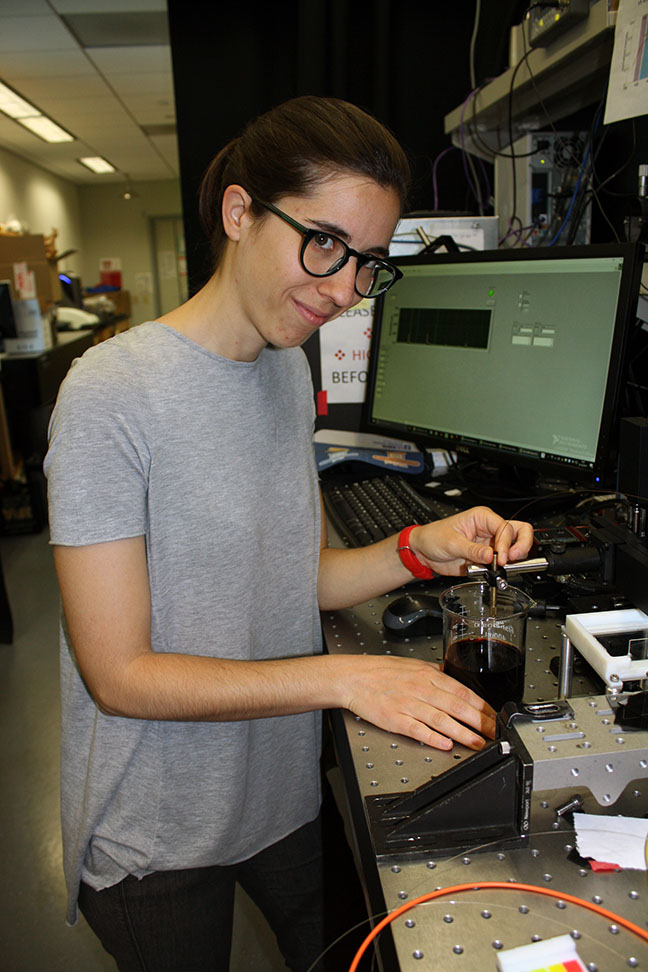
Medical imaging technology could light the way to better wine
If you ask a winemaker how they get the right balance of tannins and flavors in their wine, they’ll tell you it’s more of an art than a science. But a surprising new use for medical imaging optical technology developed by a UC Davis biomedical engineer might take some of the guesswork out of wine pressing decisions with an inexpensive, easy way to measure phenols, tannins, and other components that make tasting wine a delightful experience.
Laura Marcu, a professor of biomedical engineering, has received a grant from the American Vineyard Foundation to use a biophotonic technology developed in her laboratory for tissue diagnosis as a means to obtain information about the intrinsic components of wine. When light shines on these compounds they can emit light of their own, like a rainbow, called fluorescence. Marcu’s technology detects not only the colors the components of wine emit but also for how long each component emits light – a property called fluorescence lifetime – that can provide a fingerprint for each wine component.

Marcu has already developed tools that use fluorescence lifetime spectroscopy and imaging to help surgeons delineate the margins of tumors in patients in real time, particularly in the brain and mouth, remotely using fiber optics. Now, in collaboration with Andrew Waterhouse, a professor of viticulture and enology at UC Davis, she will turn them on wine to develop new ways to rapidly “diagnose” wine in containers – that could make winemaking as much a science as an art.
Marcu lab postdoc Alba Alfonso Garcia will illuminate a wine sample with a short pulse of light from a fiber optic probe. The optical device simultaneously measures the emitted fluorescence at multiple wavelengths, and follows its fast decay – just a few nanoseconds.
“This shows how versatile biophotonic technologies such as the fluorescence lifetime spectroscopy developed for health care can be,” Marcu explains. “We are learning that the same technologies used to diagnose cardiovascular diseases, tumors, and engineered tissues for regenerative medicine can also be used to evaluate the properties and the quality of wine. The Romans used to say, in vino veritas. Maybe soon we can add to that, in fluorescence lifetime, truth.”
The American Vineyard Foundation grant will allow Marcu and Waterhouse to evaluate which excitation and fluorescence wavelengths provide the best sensitivity to tannin, and to obtain the fluorescence characteristics of phenolic standards to determine the optimal and accessible spectral evaluation. They plan to look for unique signatures for each class of phenolic compounds and characterize their fluorescence lifetime, and evaluate mixtures of phenolic compounds to find out if the method is feasible for complex mixtures.

With a diligent analysis of the fluorescence spectral and lifetime data, Marcu and Waterhouse believe they will be able to measure tannin and phenolic compounds rapidly and with good precision. Once they have determined a set of fluorescence features, it should be possible to create a simple fiber optic device that uses inexpensive light sources, such as LEDs or laser diodes, and custom electronic circuitry. With a fiber optic probe dropped directly into a fermentation tank, a winemaker could measure the tannin in just one second.
By pressing off red wine fermenters as soon as the desired phenolic/tannin level is attained, they can be used more times during harvest. This practice effectively increases the capacity of a facility. In addition, high color and tannin pomace can be reused to improve the structure of wine from lower quality fruit. Multiple tanks could be also sampled at once to save money and time, providing a fast return on investment in the device.
“Medical technologies can pay off in unexpected ways. Many of them have flexibility to cover all the space between medicine and wine,” says Marcu. “At UC Davis, we have the full spectrum of research facilities, from our outstanding biomedical engineering research, to our world class medical and viticulture research that allows us to discover and capitalize on the wide variety of technologies our scientists develop.”
